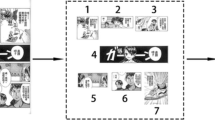Abstract
Comic page segmentation aims to automatically decompose scanned comic images into storyboards (frames), which is the key technique to produce digital comic documents that are suitable for reading on mobile devices. In this paper, we propose a novel method for comic page segmentation by finding the quadrilateral enclosing box of each storyboard. We first acquire the edge image of the input comic image, and then extract line segments with a heuristic line segment detection algorithm. We perform line clustering to further merge the overlapped line segments and remove the redundancy line segments. Finally, we perform another round of line clustering and post-processing to compose the obtained line segments into complete quadrilateral enclosing boxes of the storyboards. The proposed method is tested on 2,237 comic images from 12 different printed comic series, and the experimental results demonstrate that our method is effective for comic image segmentation and outperforms the existing methods.






















Similar content being viewed by others
References
Arai K, Tolle H (2010) Automatic e-comic content adaptation. Int J Ubiquit Comput 1(1):1–11
Ballard DH (1981) Generalizing the Hough transform to detect arbitrary shapes. Pattern Recognit 13(2):111–122
Burns JB, Hanson AR, Riseman EM (1986) Extracting straight lines. IEEE Trans Pattern Anal Mach Intell 8(4):425–455
Canny J (1986) A computational approach to edge detection. IEEE Trans Pattern Anal Mach Intell 8(6):679–698
Chung KL, Lin ZW, Huang ST, Huang YH, Liao HYM (2010) New orientation-based elimination approach for accurate line-detection. Pattern Recognit 31:11–19
Forsyth DA, Ponce J (2002) Computer vision: a modern approach, 1st edn. Prentice Hall 467–490
Gioi RG, Jakubowicz J, Morel JM, Randall G (2010) LSD: a fast line segment detector with a false detection control. IEEE Trans Pattern Anal Mach Intell 32(4):722–732
Grana C, Borghesani D, Cucchiara R (2010) Optimized block-based connected components labeling with decision trees. IEEE Trans Image Process 19(6):1596–1609
Ho CT, Chen LH (1996) A high-speed algorithm for line detection. Pattern Recognit Lett 17:467–473
In Y, Oie T, Higuchi M, Kawasaki S et al (2010) Fast frame decomposition and sorting by contour tracing for mobile phone comic images. Proc. International Conference on Visualization, imaging and simulation (VIS), Wisconsin, 2010:23–28
Ishii D, Watanabe H (2010) A study on frame position detection of digitized comic images. Workshop on Picture Coding and Image Processing (PCSJ), Nagoya, 2010:124–125
Jain AK, Yu B (1998) Document representation and its application to page decomposition. IEEE Trans Pattern Anal Mach Intell 20(12):294–308
Lo RC, Tsai WH (1995) Gray-scale Hough transform for thick line detection in gray-scale images. Pattern Recognit 28(5):647–661
Lowe DG (2004) Distinctive image features from scale-invariant keypoints. Int J Comput Vis 60(2):91–110
Tanaka T, Shoji K, Toyama F, Miyamichi J (2007) Layout analysis of tree-structured scene frames in comic images. Proc. International Joint Conferences on Artificial Intelligence (IJCAI), Hyderabad, January 2007: 2885–2890
Theodoridis S, Koutroumbas K (2008) Pattern recognition, 4th edn. Academic Press 20–50
Viola P, Jones MJ (2004) Robust real-time face detection. Int J Comput Vis 57(2):137–154
Xi J, Hu J, Wu L (2002) Page segmentation of Chinese newspapers. Pattern Recognit 35(12):2695–2704
Yamada M, Budiarto R, Endoo M, Miyazaki S (2004) Comic image decomposition for reading comics on cellular phones. IEICE Trans Inf Syst E87-D(6):1370–1376
Acknowledgments
This work is supported by National Basic Research Program of China, also Named “973 Program” (No. 2010CB735908).
Author information
Authors and Affiliations
Corresponding authors
Rights and permissions
About this article
Cite this article
Li, L., Wang, Y., Tang, Z. et al. Automatic comic page segmentation based on polygon detection. Multimed Tools Appl 69, 171–197 (2014). https://doi.org/10.1007/s11042-012-1241-7
Published:
Issue Date:
DOI: https://doi.org/10.1007/s11042-012-1241-7




